My Chinese mushroom noodle soup recipes features rice noodles accompanied by white beech mushrooms (also called Shimeji mushrooms), onion, and okra. Rice vermicelli are the thin rice noodles used in familiar dishes such as Singapore noodles.

The white beech mushrooms and okra make Chinese mushroom noodle soup more flavorful and nutritious. The mushrooms also add a contrasting slightly crunchy texture. I don’t use too much seasoning: I like to let the soup keep its natural flavor. Shimeji or white beech mushrooms are so called because they typically grow on the logs of downed beech trees. If you can’t get the white beech mushrooms in the recipe, you can substitute button mushrooms (also called “common” mushrooms) instead.
How to prepare dried rice vermicelli noodles
When you get a portion of dried vermicelli, how do you want to cook it? What cooking methods do you use? In China, vermicelli is eaten in many ways. Stir-fry, deep-fry, boil, steam. All these cooking methods can make vermicelli delicious. This mushroom noodle soup recipe uses the boiling method to prepare the dried noodles, so it can be a soup or as a main dish, just like boiled wheat or alkali noodles. The first step in processing dried vermicelli is to soak them in cold water first, so as to shorten the cooking time. The soft vermicelli obtained in this way is the best result. You can do this step first, and then prepare the other steps.
Chinese Mushroom Noodle Soup
Equipment
- 1 wok
- 1 bowl (for soaking the rice noodles)
- 1 sauce pan (for boiling the 500 ml water)
- 1 deep bowl or serving dish
Ingredients
- 20 g dried rice vermicelli
- 100 g white beech mushrooms
- 2 okra pods
- 50 g red onion
- 5 g cilantro
- 1 scallion
- 2 cloves garlic
- 15 ml cooking oil
- 4 ml salt, divided (1 ml, 3ml)
- 5 ml light soy sauce
- 5 ml toasted sesame oil
- 2 ml white pepper
- 500 ml hot water near boiling
Instructions
- Prepare the ingredients. Wash them clean. Place the mushrooms in a bowl of cold water and swish them around to remove any dirt. Discard the water.
- Soak the dried rice vermicelli in cold water for 20-30 minutes to soften.20 g dried rice vermicelli
- Slice the garlic cloves and red onion. Chop the cilantro and green onions and mix them together. Remove the head and tail of the okra and slice them. Cut the long mushrooms into 2-3 pieces. Place a saucepan or kettle with 500 ml on high heat, bring to a boil, and let cool slightly.
- Add 15ml of cold oil into the wok. Add the garlic and onion. Fry over medium heat until fragrant. When slightly yellow, remove the garlic and onion, but keep the oil in the wok.50 g red onion, 15 ml cooking oil, 2 cloves garlic
- Add the mushrooms, 1ml salt and 5ml soy sauce. Use medium-low heat and stir-fry for 2 minutes to cook evenly.100 g white beech mushrooms, 4 ml salt, divided, 5 ml light soy sauce
- Pour the 500 ml of near-boiling (90-100 C / 194-212 F) water over the mushrooms.500 ml hot water
- Bring the water back to a boil, then removed the noodles from their soaking water and add the rice vermicelli and okra to the wok. Season with 3ml salt and 2ml white pepper or to taste.20 g dried rice vermicelli, 2 okra pods, 2 ml white pepper, 4 ml salt, divided
- Return the water to a boil, turn off the heat, add 5ml sesame oil, stir well, and pour into a bowl. Sprinkle with chopped green onions and cilantro and serve.5 g cilantro, 1 scallion, 5 ml toasted sesame oil
Notes
- You don’t need to cook the vermicelli for too long after it’s been soaked. Bring the water in the wok back to a boil before adding the rice noodles, then remove from heat as soon as the water returns to a boil.
- If you don’t have much time to soak the vermicelli, you can use warm water, which can save some time.
Nutrition
Do you enjoy My Chinese Home Kitchen?
We enjoy sharing these authentic home recipes with you. My Chinese Home Kitchen is a labor of love.
Please tell your friends about us!
Learn more about My Chinese Home Kitchen at our About page.
Please leave a comment, or SUBSCRIBE to our newsletter.
For more of our original videos, visit My Chinese Home Kitchen on YouTube and Rumble.


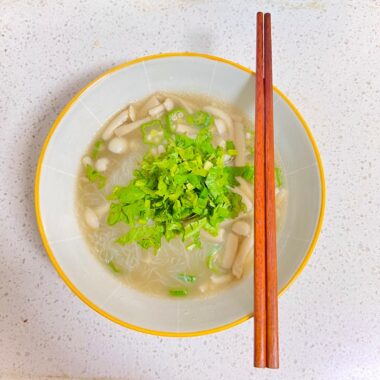

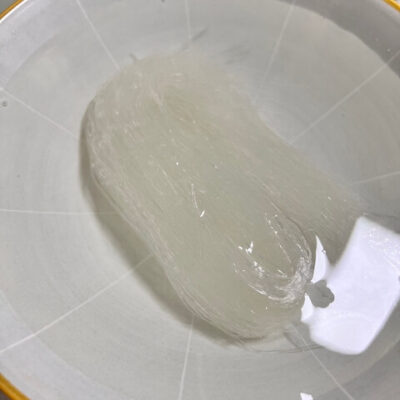
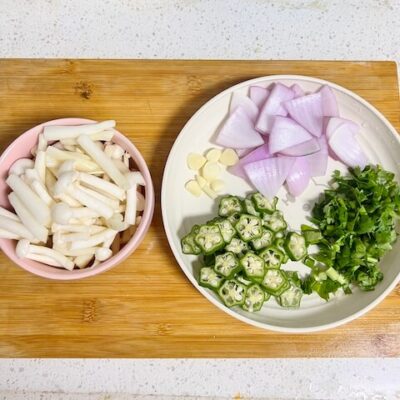


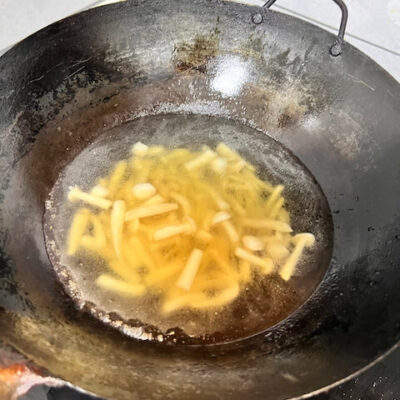

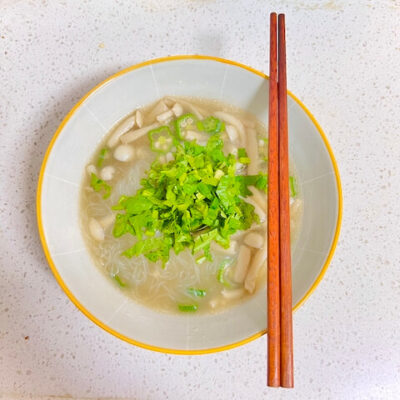

Tasty. The sesame oil gives a nice flavor.